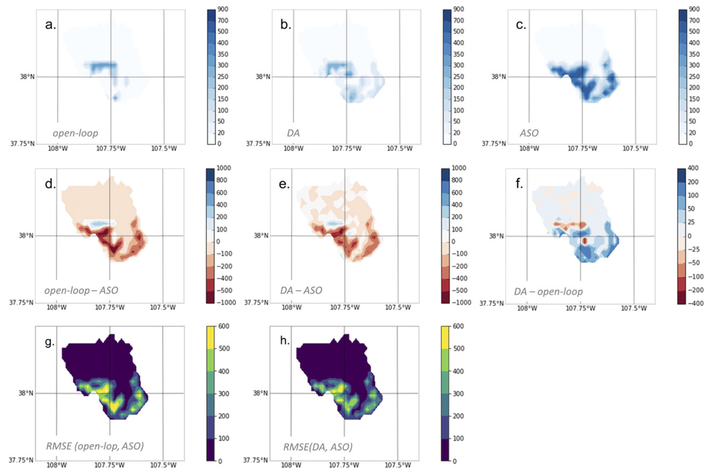A High-Resolution Data Assimilation Framework for Snow Water EquivalentEstimation across the Western United States and Validation with theAirborne Snow Observatory
 Modeled and observed springtime SWE (mm) in the Uncompahgre basin, CO for WY 2015, averaged over ASO-available datesfor given water years for (a) open loop, (b) DA, (c) ASO observations, (d) open loop minus ASO, (e) DA minus ASO, (f) DA minus openloop, (g) RMSE for open loop and ASO, and (h) RMSE for DA and ASO.
Modeled and observed springtime SWE (mm) in the Uncompahgre basin, CO for WY 2015, averaged over ASO-available datesfor given water years for (a) open loop, (b) DA, (c) ASO observations, (d) open loop minus ASO, (e) DA minus ASO, (f) DA minus openloop, (g) RMSE for open loop and ASO, and (h) RMSE for DA and ASO.Abstract
Numerical simulations of snow water equivalent (SWE) in mountain systems can be biased, and few SWEobservations have existed over large domains. New approaches for measuring SWE, like NASA’s ultra-high-resolution Airborne Snow Observatory (ASO), offer an opportunity to improve model estimates byproviding a high-quality validation target. In this study, a computationally efficient snow data assimilation(DA) approach over the western United States at 1.75-km spatial resolution for water years (WYs) 2001–17 ispresented. A local ensemble transform Kalman filter implemented as a batch smoother is used with the VIChydrology model to assimilate the remotely sensed daily MODIS fractional snow-covered area (SCA).Validation of the high-resolution SWE estimates is done against ASO SWE data in the Tuolumne basin(California), Uncompahgre basin (Colorado), and Olympic Peninsula (Washington). Results indicate goodperformance in dry years and during melt, with DA reducing Tuolumne basin-average SWE percent dif-ferences from268%,292%, and284% in open loop to 0.6%, 25%, and 3% after DA for WYs 2013–15,respectively, for ASO dates and spatial extent. DA also improved SWE percent difference over theUncompahgre basin (284% open loop,265% DA) and Olympic Peninsula (26% open loop,20.2% DA).However, in anomalously wet years DA underestimates SWE, likely due to an inadequate snow depletioncurve parameterization. Despite potential shortcomings due to VIC model setup (e.g., water balance mode)or parameterization (snow depletion curve), the DA framework implemented in this study shows promise inovercoming some of these limitations and improving estimated SWE, in particular during drier years or athigher elevations, when most in situ observations cannot capture high-elevation snowpack due to lack ofstations there.